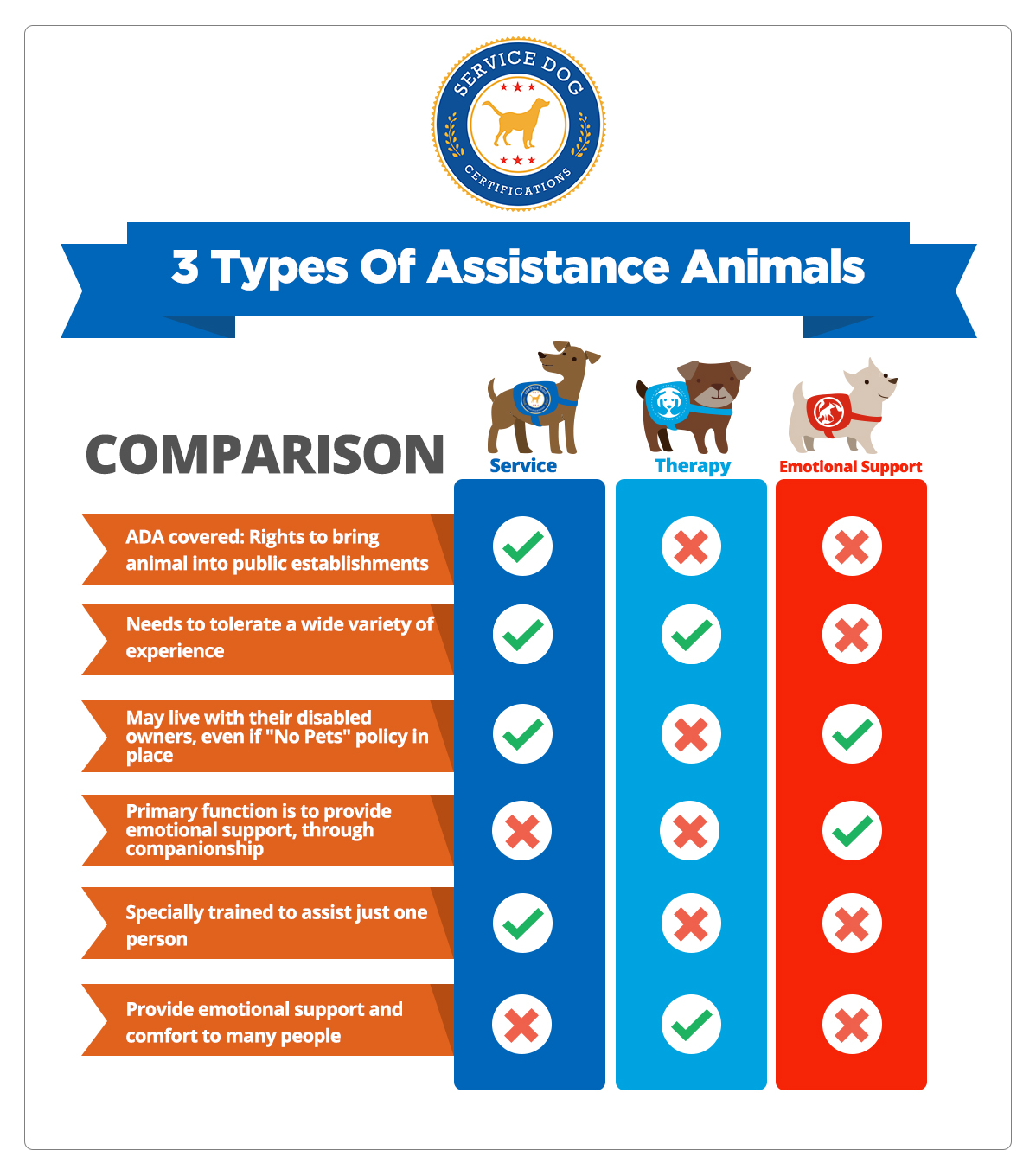The Difference Between Service Dogs, Emotional Support Animals, and Therapy Dogs

These are the key differences between service dogs, emotional support animals, and therapy dogs: Service dogs are trained to perform specific tasks for people with disabilities and have full public access rights and air travel rights under the ADA and ACAA. Emotional support animals provide comfort through their presence alone and have housing protections under the Fair Housing Act, but no public access rights. Therapy dogs visit multiple people in facilities like hospitals and schools to provide comfort, but have no special federal legal protections.
- Service dogs have full public access and travel rights
- Service dogs perform tasks that help their handler’s disability
- Service dogs DON’T require official government certification
- Emotional support animals provide comfort through their presence alone
- Emotional support animals have housing rights
- Emotional support animals require an ESA letter
- Emotional support animals DON’T have public access rights
- Emotional support animals DON’T need specialized training
- Therapy dogs visit multiple people, not just their handler
- Therapy dogs DON’T have any special federal legal protections
- Therapy dogs DON’T have public access rights
In this article:
- Differences in how they help
- Housing differences
- Public access differences
- Training differences
- Documentation differences
- Legal status differences
Differences in How They Help
Service dogs, emotional support animals, and therapy dogs help their human friends in different ways. Service dogs are working professionals trained to perform tasks to help with a disability. That includes tasks for physical disabilities, like acting as a guide, retrieving dropped items, opening doors, providing mobility support, or even helping with dressing. Psychiatric service dogs are also able to help people with invisible, mental health disabilities. Check out our lists of service dog tasks to get an idea of what service dogs are capable of.
Emotional support animals, on the other hand, are used solely for mental and emotional health. Unlike service dogs, ESAs aren’t trained to perform specific tasks. Instead, their companionship naturally helps by providing comfort, routine, and emotional connection. For example, while a psychiatric service dog might be trained to perform deep pressure therapy during a panic attack, an ESA helps reduce the frequency or intensity of those panic attacks through the ongoing emotional support they provide at home.
Therapy dogs offer something entirely different — they’re the community wellness counselors of the canine world. Rather than helping one specific person, they bring brief moments of joy, comfort, and healing to many different individuals in structured settings. A therapy dog visiting a children’s hospital isn’t addressing anyone’s specific disability; they’re offering a welcome emotional boost to everyone they encounter. It’s a beautiful service, but fundamentally different from the disability assistance provided by service dogs or the individual mental health support of ESAs.
Housing Differences
When it comes to where these animals can live, service dogs and ESAs both enjoy Fair Housing Act protections — meaning they can live with their handlers regardless of “no pets” policies, without extra fees or deposits. Landlords also can’t apply breed or size restrictions when it comes to service dogs and emotional support animals.
Therapy dogs, meanwhile, get no special housing treatment. It doesn’t matter that your sweet Corgi might bring smiles to nursing home residents, as far as housing laws are concerned, they’re just a pet, subject to all the usual pet policies and fees.
Public Access Differences
Service dogs have public access rights under the Americans with Disabilities Act, permitting them to accompany their handlers in virtually all public spaces — restaurants, retail establishments, healthcare facilities, and government buildings.
However, emotional support animals and therapy dogs do not have these federal public access protections. Neither ESAs nor therapy dogs have the legal right to enter public establishments that don’t allow dogs. Therapy dogs gain entry to specific facilities (such as hospitals, educational institutions, or retirement communities) through formal, prearranged visitation programs, while emotional support animals generally remain classified as pets in public settings, without special accommodation requirements.
Training Differences
Service dogs require extensive professional training, while ESAs need no special training, and therapy dogs fall somewhere in between, with a focus on temperament rather than tasks.
Service dogs complete rigorous training in two areas: specific disability-mitigating tasks and public access behavior. Their specialized abilities go beyond basic obedience — they master complex behaviors like retrieving items, providing mobility assistance, alerting to medical events, or interrupting psychiatric symptoms. If you’re interested in training a dog to become a service animal, check out our basic training guide for service dogs.
Emotional support animals require no specialized training under current laws. Their benefit comes naturally from the human-animal bond rather than from trained behaviors. While basic manners make for happier housing situations, they’re not legally required for the animal to qualify for accommodations.
Therapy dogs require excellent temperament and reliable behavior around strangers and in various environments, but don’t need disability-specific task training. Most therapy dog organizations require behavior assessments and basic obedience certification before allowing facility visits.
Documentation Differences
Service dogs need no official paperwork despite having the most access rights, ESAs require a professional letter, and therapy dogs have no document requirements under federal law.
Despite their extensive access rights, service dogs don’t require any government documentation or certification. Their qualification comes from functionality: the handler must have a disability, and the dog must perform specific tasks that mitigate that disability. No federal registry exists, and businesses cannot legally demand certification for access. Owners of psychiatric service dogs, however, will sometimes get a PSD letter for assurance.
Emotional support animals require documentation from a licensed mental health professional. This letter must verify that the person has an eligible mental health condition and the therapeutic benefit of the animal’s presence.
Therapy dogs often work within established organizations that provide certification, testing, and insurance coverage. There is, however, no formal documentation requirement under federal law.
Legal Status Differences
Service dogs enjoy comprehensive federal protection, ESAs have limited housing rights only, and therapy dogs have virtually no special legal status at all.
Service dogs receive protection under multiple federal laws: ADA service dog rules establish their public access rights, the Fair Housing Act secures their housing accommodations, and the Air Carrier Access Act addresses their air travel rights.
Emotional support animals have narrower protection, primarily under housing law. Since December 2020, when the Department of Transportation revised regulations, ESAs lost their special rights for air travel and are now effectively classified as pets on commercial flights. They have no federally protected public access rights.
Therapy dogs hold essentially no special federal legal protection. Their access to facilities occurs through invitation and established programs rather than legal entitlement.

Share this image on your site
We’ve consulted with the experts to clear up the mystery and misunderstanding of this important trio.
About the Author: The writing team at Service Dog Certifications is made up of folks who really know their stuff when it comes to disability laws and assistance animals. Many of our writers and editors have service dogs themselves and share insights from their own experiences. All of us have a passion for disability rights and animals.
1 comment
Leave a Reply Cancel reply
Latest Posts

Dangerous Materials Hiding in Your Dog Products
Jake’s German Shepherd began developing strange rashes around his collar. Three vet visits later, they figured out the leather was treated with chromium — a chemical that irritates sensitive skin. Jake had no idea his dog’s collar contained industrial chemicals. Most dog owners don’t know what goes into the products they buy. Many companies use […]

Read More

Can You Bring a Service Dog to a Basketball Game?
Yes, you absolutely can bring your service dog to basketball games. Whether you’re heading to your local high school tournament, a packed college rivalry game, or splurging on NBA tickets, the Americans with Disabilities Act protects your right to be accompanied by your service dog anywhere the public can go. When you arrive, venue employees […]

Read More

Best Pet Health Insurance Providers
If you own a pet, you know how important — and expensive — vet care can be. One way to offset those costs is to purchase pet health insurance. Like typical health insurance, pet insurance is available at many price points, and can cover all, most, or only some of your vet-related costs. It can […]

Read More

I need to change from Service Dog to emotional support dog.